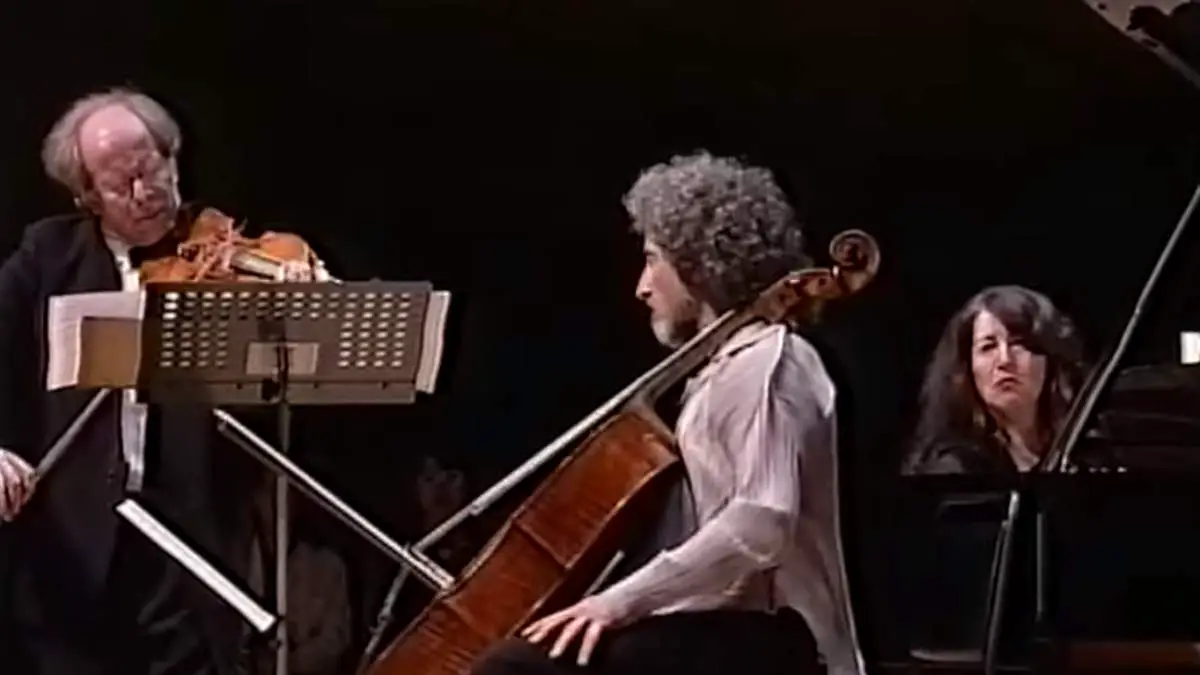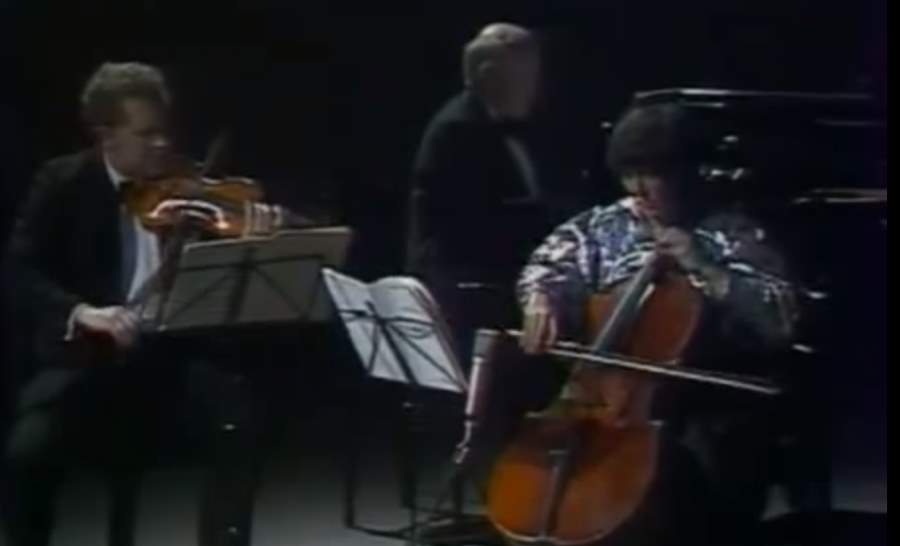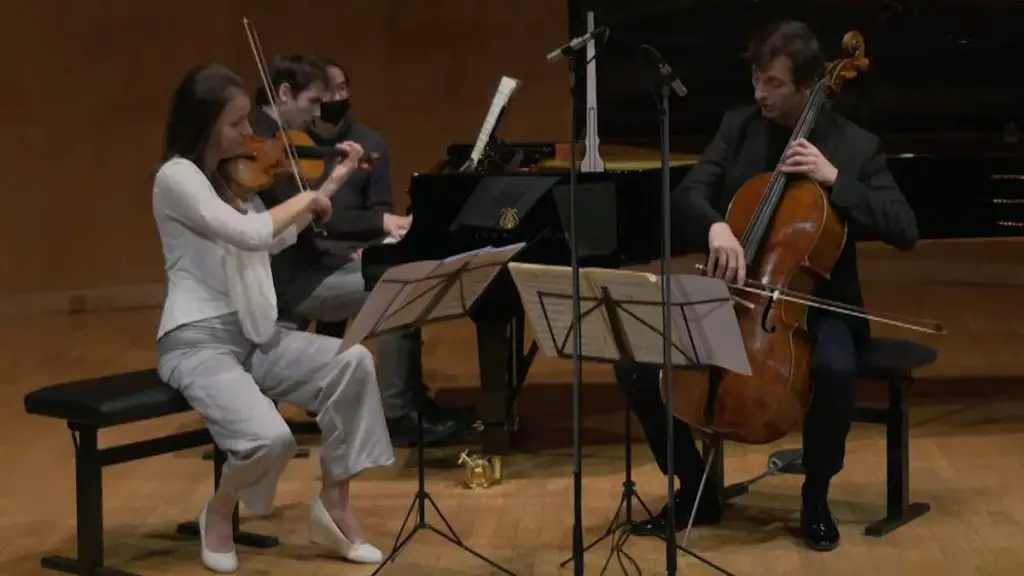Martha Argerich (piano), Gidon Kremer (violin), and Mischa Maisky (cello) perform Pyotr Ilyich Tchaikovsky’s Piano Trio in A minor, Op. 50. This performance was recorded in 1998 in Japan. Encore: Tango Pathetique by Peter Kiesewetter.
Tchaikovsky’s Piano Trio
Tchaikovsky’s Piano Trio in A minor, Op. 50, is a unique and deeply emotional piece within his oeuvre, dedicated to the memory of his close friend and mentor, Nikolai Rubinstein, who was a renowned pianist and conductor. Composed in 1881-1882, this work stands out as Tchaikovsky’s only significant composition for a piano trio and reflects his complex feelings of grief and remembrance. The subtitle, “In memory of a great artist,” signifies its elegiac intent.
Tchaikovsky was initially reluctant to write for this combination of instruments—piano, violin, and cello—claiming that it was difficult to balance the sonorous piano with the more delicate sounds of the strings. However, in this trio, he skillfully manages to integrate the three instruments, creating a rich, cohesive texture that allows each instrument to shine while contributing to the overall emotional and thematic development of the piece.
The composition is expansive and structured in two major sections rather than the traditional three or four movements of a typical trio. This format includes a first section that explores a variety of themes and a set of variations in the second section, each presenting distinct moods and characters, showcasing Tchaikovsky’s lyrical gifts and his capacity for deep emotional expression. The work is both reflective and virtuosic, containing some of the most challenging passages in the chamber music repertoire.
Tchaikovsky’s Piano Trio is celebrated for its profound depth and the beauty of its melodies, exemplifying his ability to convey intense feelings through music. The piece is a staple in the chamber music repertoire, frequently performed and recorded by trios worldwide, and remains a poignant tribute to friendship and loss.
First Movement: Pezzo elegiaco [Moderato assai – Allegro giusto]
The first movement of the trio, titled “Pezzo elegiaco,” translates to “elegiac piece.” It begins with a solemn and deeply expressive introduction marked “Moderato assai,” which sets a mournful tone reflective of the work’s dedication “In memory of a great artist,” honoring Nikolai Rubinstein. The piano introduces the main theme, a poignant and lyrical melody that is soon taken up and elaborated by the violin and cello, developing through a series of emotional and dynamic variations.
As the movement progresses into the “Allegro giusto” section, the music gains momentum, showcasing Tchaikovsky’s rich harmonic language and his ability to write complex, intertwined parts for the piano and strings. The interaction between the instruments intensifies, weaving a dense, emotive texture that captures a range of feelings from lamentation to passionate outbursts, before returning to the somber mood of the opening.
The movement concludes with a recapitulation of the main themes, now transformed and deepened by their developmental journey, ending in a tragic and powerful climax that fades into a hauntingly reflective coda. This movement is a profound expression of grief and remembrance, utilizing the full expressive range of the trio format to explore the depths of Tchaikovsky’s emotional response to his friend’s death.
Second Movement: Tema con variazioni
The second and final part of the trio is a theme and variations, which begins with a simple, elegiac theme introduced by the piano and then picked up by the violin and cello. This theme serves as the foundation for a series of eleven variations that explore a wide array of textures, moods, and technical challenges.
Each variation transforms the theme dramatically, ranging from delicate and lyrical treatments to more robust and rhythmically intense interpretations. Some variations are contemplative and introspective, featuring lush harmonies and melodic beauty, while others are vigorous and virtuosic, displaying the technical prowess of the performers. Tchaikovsky makes use of a broad palette of instrumental colors and interactions, highlighting the unique capabilities of each instrument in the ensemble.
The variations culminate in a powerful finale that revisits the elegiac spirit of the opening movement. The final variation is particularly dramatic and expansive, incorporating fugal elements and a climactic build-up that leads to an emotionally charged conclusion. After the intensity of the last variation, the piece ends with a return to the theme in a more subdued and reflective manner, bringing the trio to a poignant and introspective close.
This second movement not only showcases Tchaikovsky’s compositional skill and inventiveness but also serves as a compelling narrative arc in its own right, reflecting a journey through grief and the composer’s homage to his departed friend. The theme and variations format allows for a deep exploration of emotional and musical ideas, making it a fitting tribute and a powerful conclusion to the trio.
The variations are as follows:
- Var I
- Var II: Più mosso
- Var III: Allegro moderato
- Var IV: L’istesso tempo (Allegro moderato)
- Var V: L’istesso tempo
- Var VI: Tempo di Valse
- Var VII: Allegro moderato
- Var VIII: Fuga (Allegro moderato)
- Var IX: Andante flebile, ma non tanto
- Var X: Tempo di mazurka
- Var XI: Moderato
- Variazioni finale e coda: Allegro risoluto e con fuoco
- Coda: Andante con moto – Lugubre (L’istesso tempo)
Sources
- Piano Trio (Tchaikovsky) on Wikipedia
- Piano Trio, Op.50 (Tchaikovsky, Pyotr) on the International Music Score Library Project website
- Brahms: Violin Sonata No. 1 [Yuja Wang, Leonidas Kavakos] - May 3, 2024
- Chopin: Prelude No. 15 “Raindrop” [YUNDI] - May 1, 2024
- Beethoven: Piano Concerto No. 3 [Olga Scheps] - April 30, 2024



